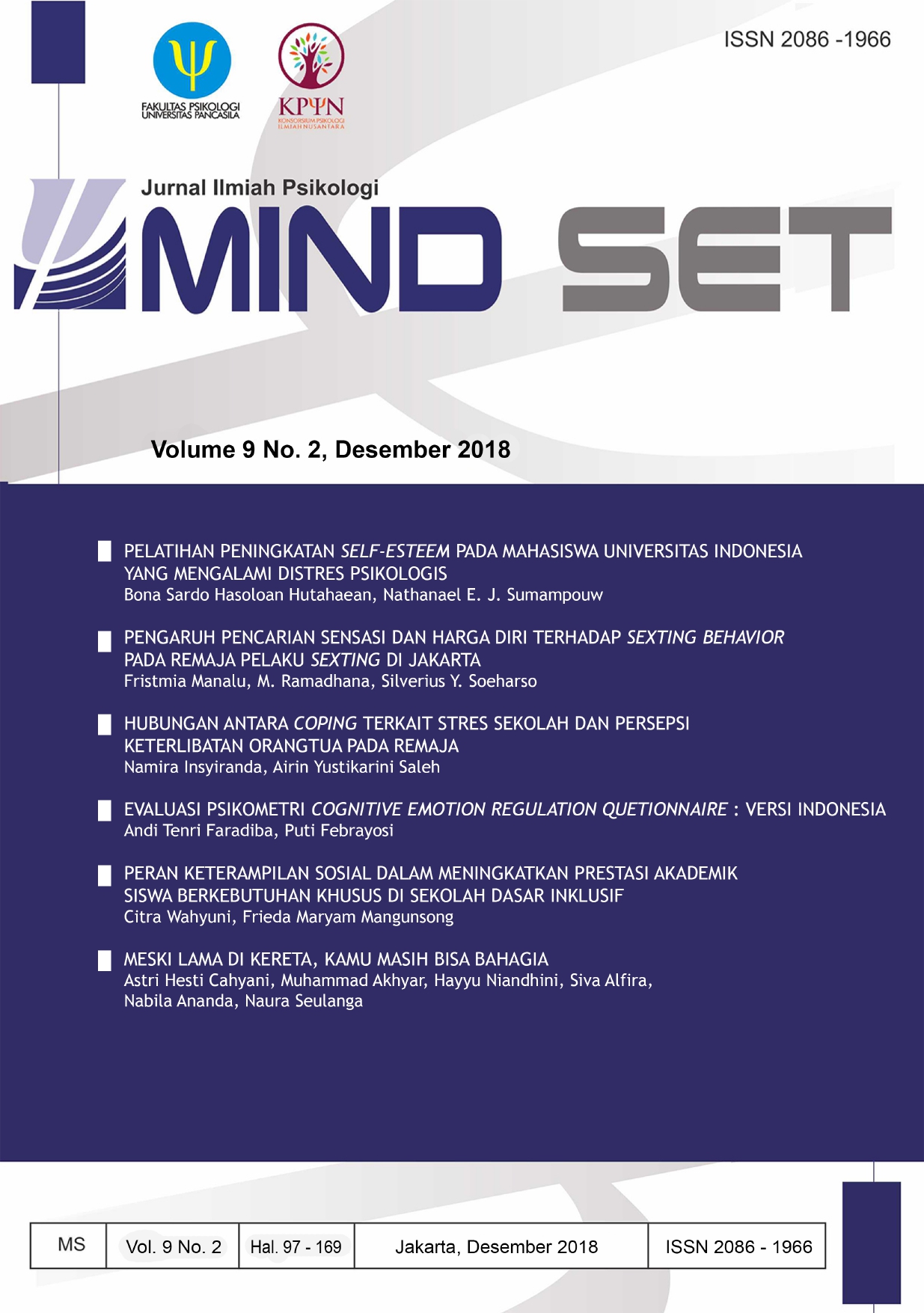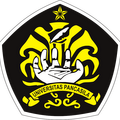Pelatihan Peningkatan Self-Esteem pada Mahasiswa Universitas Indonesia yang Mengalami Distres Psikologis
Abstract views: 2700 | PDF (Bahasa Indonesia) downloads: 2382
Abstract
Undergraduate students with high levels of self-esteem tend to have good adjustments in lectures. They will have the ability to deal with college problems and automatically reduce their psychological distress. This study used a quasi experimental method which is conducted to determine the increase of self-esteem in students who experience psychological distress. Participants of this study were 8 undergraduate students from Universitas Indonesia aged 18-23 years with a level of self-esteem below the value of 29 as measured by Rosenberg self-esteem scale (RSES), and had a level of psychological distress above the value of 1.75 as measured by HSCL-25. Participants were involved in the intervention of increasing self-esteem consisting of 5 main sessions for two consecutive days (about 6 hours a day). Four weeks after the second day of training, the participant's level of self-esteem and psychological distress were measured. The result of pre and posttest intervention showed that the participant’s mean score of self-esteem increased and the mean score of psychological distress decreased. The result of Wilcoxon test also showed a significant change in both variables (Z RSES = -2.246; Z HSCL-25 = -2.366; p < .05). This study shows that training intervention is effective in increasing the level of self-esteem and reducing the level of psychological distress for undergraduate students at Universitas Indonesia. Participants also commented that they gained new knowledge about self-esteem and new skills to communicate assertively and think positively.
References
Abdullah, M. C., Elias, H., Mahyuddin, R., & Uli, J. (2009). Adjustment amongst first year students in a Malaysian University. European Journal of Social Sciences, 8(3), 496-505.
Agochiya, D. (2002). Every Trainer’s Handbook. New Delhi: Sage Publications India Pvt Ltd.
Arnett, J. J. (2000). Emerging adulthood: A theory of development from the late teens through the twenties. American Psychologist, 55(5), 469-480. doi: 10.1037/0003-066x.55.5.469
Baumeister, R. F., Campbell, J. D., Krueger, J. I., & Vohs, K. D. (2003). Does high self-esteem cause better performance, interpersonal success, happiness, or healthier life style? Psychological Science in the Public Interest, 4(1), 1-44.
Bloom, B. S. (1975). Taxonomy of educational objectives. New York: David McKay Co, Inc.
Brown, J. D. (1998). The self. Boston: McGraw-Hill.
Cloutte, P. (2001). How to increase your self-esteem. Mental Health Promotion Series (booklet). London: Mind Publications.
Della. (2010). Hubungan antara harga diri, citra tubuh, dan kecemasan sosial pada remaja putri tingkat SMP di Jakarta (Skripsi tidak diterbitkan). Universitas Katolik Indonesia Atma Jaya, Jakarta.
DeRosier, M. E., PhD., Frank, E., PhD., Schwartz, V., M.D., & Leary, K. A., PhD. (2013). The potential role of resilience education for preventing mental health problems for college students. Psychiatric Annals, 43(12), 538-544. doi:http://remote-lib.ui.ac.id:2090/10.3928/00485713-20131206-05
Duffy, K. G., & Atwater, E. (2002). Psychology for living: Adjustment, growth, and behavior today (7th Ed.). New Jersey: Pearson Education, Inc.
Furjanic, S. W. & Trotman, L. A. (2000). Turning Training into Learning: How to Design and Deliver Programs That Get Results. USA: AMACOM.
Gravetter, F. J., & Wallnau, L. B. (2010). Statistics for the Behavioral Sciences (9th Ed.). USA: Cengage Learning.
Hales, D. (2009). An Invitation to Health (13th Ed.). Belmont, CA: Wadsworth/Cengage Learning.
Jarvis, P. (1987). Adult Learning in the Social Context. London: Routledge, https://doi.org/10.4324/9780203802724
Kaaya, S. F., Fawzi, M.C., Mbwambo, J. K., Lee, B., Msamanga, G. I., Fawzi, W. (2002). Validity of the Hopkins Symptom Checklist-25 amongst HIV-positive pregnant women in Tanzania. UK: Blackwell Munksgaard.
Kerlinger, F. N., & Lee, H. B. (2000). Foundations of behavioral research (4th Ed.). USA: Harcourt, Inc.
Kolb, D. A. (1984). Experiential Learning: Experience as the Source of Learning and Development. New Jersey: Prentice-Hall, Inc.
Kumar, R. (1999). Research methodology: A step by step guide for beginners. London: Sage Publications, Ltd.
Laird, D. (1985). Approaches to training and development (2nd Ed.). Massachusetts: Addison Wesley Publishing Company.
Lim, L., Saulsman, L., & Nathan, P. (2005). Improving Self-Esteem. Perth, Western Australia: Centre for Clinical Interventions.
Maishella, P. (2011). Masalah Adjustment to college work dan faktor prediktor psychological distress pada mahasiswa tahun kedua di Universitas Indonesia (Skripsi tidak dipublikasikan). Universitas Indonesia, Depok.
Matthews, G. (2000). Distress. In Fink (Ed.), Encyclopedia of stress (Vol. 1, pp A–D). New York: Academic Press.
Mazaheri, A., Fatehizadeh, M., & Asemi, A. (2011). Effect of behavioral-cognitive self-esteem group training on students’ social adjustment. Interdisciplinary Journal of Contemporary Research in Business, 3(2), 202-209.
Mirowsky, J., & Ross, C. E. (2003). Social cause of psychological distress. New York: Aldine de Gruyter.
Mooney, R. L., & Gordon, L. V. (1978). Mooney problem check-list. United States of America: Harcout Brace Jovanovich, Inc.
Mruk, C. J. (2006). Self-Esteem research, theory, and practice: Toward a positive psychology of self-esteem (3rd Ed.). New York: Springer Publishing Company, Inc.
Naderi, H., Abdullah, R., Aizan, H. T., Sharir, J., & Kumar, V. (2009). Self-esteem, gender and academic achievement of undergraduate students. American Journal of Scientific Research, 3, 26-37.
Napitupulu, E. L. (2012, September 12). PTN Indonesia masuk Universitas top dunia. Kompas.com. Diunduh dari https://edukasi.kompas.com/read/2012/09/12/1703257/PTN.Indonesia.Masuk.Universitas.Top.Dunia
No Name. (2009). Counselling Training Manual: Trauma, Guilt, & Self-Esteem. New Delhi: International Planned Parenthood Federation.
O’Donnel, W. J. (1976). Adolescent self-esteem related to feelings toward parents and friends. Journal of Youth Adolescence, 5, 179-185.
Papalia, D. & Martorell, G. (2014). Experience human development (13th ed.). New York, NY: McGraw-Hill.
Rosenberg, M., Schooler, C., Schoenbach, C., & Rosenberg, F. (1995). Global self-esteem and specific self-esteem: Different concepts, different outcomes. American Sociological Review, 60(1), 141.
Salami, S. O. (2011). Psychosocial Predictors of Adjustment Among First Year College of Education Students. US-China Education Review, 8(2), 239-248.
Saleh, D., Camart, N., dan Romo, L. (2017) Predictors of Stress in College Students. Frontiers in Psychology. 8(19). DOI:10.3389/fpsyg.2017.00019
Sandanger, I., Moum, T., Ingebrigtsen, G., Sorensen, T., Dalgard, O. S., & Bruusgaard, D. (1999). the meaning and significance of caseness: The Hopkins Symptom Checklist-25 and The Composite International Diagnostic Interview II. Social Psychiatry and Psychiatric Epidemiology, 34, 53-59.
Santrock, J. W. (2013). Adolescence (15th Ed.). New York: McGraw-Hill.
Stallman, H. M. (2010). Psychological distress in university students: A comparison with general population data. Australian Psychologist, 45(4), 249-257. DOI:10.1080/00050067.2010.482109
Universitas Indonesia. (2007). UI dalam angka. Diunduh dari http://www.ui.ac.id/download/ui_dalam_angka.pdf
Universitas Indonesia. (2010). Panduan Kegiatan Awal Mahasiswa Baru Universitas Indonesia Tahun Akademik 2010/2011. Depok: UI Press.
Utama, B. (2010). Kesehatan mental dan masalah-masalah pada mahasiswa S1 Universitas Indonesia (Skripsi tidak dipublikasikan). Universitas Indonesia, Depok.
Vaughn, R. H. (2005). The professional trainer. San Fransisco: Berrett-Koehler Publisher, Inc.
Velicer, W. F., Prochaska, J. O., Fava, J. L., Norman, G. J., & Redding, C. A. (1998). Smoking cessation and stress management: Applications of the transtheoretical model of behavior change. Homeostatis, 38, 216-233.
Verger, P., Combes, JB., Kovess-Masfety, V., Choquet, M., Guagliardo, V., Rouillon, F., & Peretti-Wattel, P. (2009). Psychological distress in first year university students: socioeconomic and academic stressors, mastery and social support in young men and women. Social Psychiatry and Psychiatric Epidemiology, 44(8), 643-650. https://doi.org/10.1007/s00127-008-0486-y
Yatim, D. I., & Irwanto. (1986). Kepribadian keluarga dan narkotika: Tinjauan sosial psikologis. Jakarta: Arcan.










